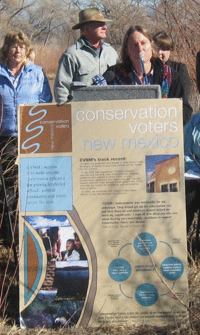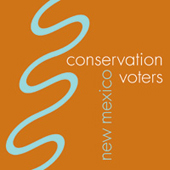Monday, January 21, 2008
Report Says Clean Energy Better for Navajo Economic Development than Desert Rock
Diné Citizens Against Ruining Our Environment (Diné CARE) held a press conference in Santa Fe on Friday, January 18, 2008 and released a new report that spells out a host of renewable energy alternatives to Desert Rock, a controversial coal-fired power plant proposed for the Navajo Reservation. Dine CARE and other environmental groups have argued that Desert Rock, which would be the third coal-fired plant in the Four Corners region, would harm the environment and residents' health
The comprehensive report contains more than 160 pages and dozens of maps, pie charts and graphs showing how renewable energy projects would compare to Desert Rock. It also provides a comprehensive look at how the tribe's Diné Fundamental Law—based on centuries of customary, traditional, natural and common law—can be applied to the modern problems of resource management and energy development.
Investing in renewable energy development and energy efficiency could provide more jobs and economic benefits for the Navajo Nation than building the proposed $3 billion Desert Rock Energy Project, according to the economic analysis, prepared in consultation with Ecos Consulting.
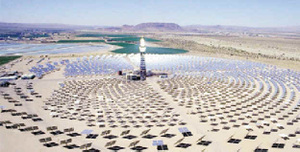
Solar power plant design prototype
The report compares sources of clean energy, such as solar and wind power, with coal, assessing economic factors such as short- and long-term employment, financial risks, environmental and health impacts, potential costs of carbon pollution, and profitability for the tribe. When the estimated economic benefits and costs of the proposed 1,500-megawatt pulverized coal power plant are weighed against benefits and costs of renewable energy development, the analysis determined that “developing clean-energy resources rather than coal provides a net economic advantage.”
 “Wind, solar and energy-efficiency technologies, which are cost-effective, reliable and available, would provide greater Navajo economic development and lower cost electricity than Desert Rock, with fewer negative consequences and more sustainable benefits,” concluded Ecos Consulting co-author Chris Calwell. “Burning coal to produce electricity is not even the best, let alone the only form of economic development for the Navajo Nation.”
“Wind, solar and energy-efficiency technologies, which are cost-effective, reliable and available, would provide greater Navajo economic development and lower cost electricity than Desert Rock, with fewer negative consequences and more sustainable benefits,” concluded Ecos Consulting co-author Chris Calwell. “Burning coal to produce electricity is not even the best, let alone the only form of economic development for the Navajo Nation.”
This claim counters the assumptions in the recent Draft Environmental Impact Statement on Desert Rock prepared by the U.S. Bureau of Indian Affairs. The federal government’s analysis predetermined the need to use Navajo coal resources without considering alternative forms of economic development and energy resources already available to the tribe.
The report states that Northern Arizona University found potential wind capacity on tribal lands in northeastern Arizona to be over 11,000 megawatts. There's also the possibility of more than 48,000 megawatts of solar generation on Navajo land, according to the report.
Click to read the entire release.
To obtain a copy of the report by Ecos Consulting, please send an email to:
- Dailan Long, email: dailan.jake@gmail.com
- Lori Goodman, email: kiyaani@frontier.net
To keep current or to get involved in activism on this issue, visit the Desert-Rock-Blog and the website of Diné CARE.
You can find some of our previous coverage of this issue here and here, including links to additional posts and other sources of information.
January 21, 2008 at 10:29 AM in Energy, Environment, Local Politics, Native Americans | Permalink | Comments (0)
Sunday, January 20, 2008
ABQ Sierra Clubs Hosts Wildlife Rescue Presentation
 From the Sierra Club Central New Mexico Group: At our next general membership meeting, Wildlife Rescue Inc. of New Mexico will present an educational program about their work raising, rehabilitating and releasing injured and orphaned wildlife here in the Albuquerque area and their efforts to educate the public about the necessity of preserving wildlife habitat. A few of their residents may be joining us as well! The meeting is on Tuesday, January 22nd, from 7 to 9 PM, at the UNM Law School (Stanford NE at Tucker Rd), Room 2405. All are welcome.
From the Sierra Club Central New Mexico Group: At our next general membership meeting, Wildlife Rescue Inc. of New Mexico will present an educational program about their work raising, rehabilitating and releasing injured and orphaned wildlife here in the Albuquerque area and their efforts to educate the public about the necessity of preserving wildlife habitat. A few of their residents may be joining us as well! The meeting is on Tuesday, January 22nd, from 7 to 9 PM, at the UNM Law School (Stanford NE at Tucker Rd), Room 2405. All are welcome.
January 20, 2008 at 01:23 PM in Environment, Events | Permalink | Comments (0)
Wednesday, January 16, 2008
Urge Legislators to Fund Rio Grande Trail
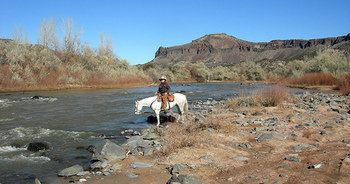
Rio Grande Cowboy, Photo Credit: Bill Manns
From Environment New Mexico:
Although still in the planning stages, the Rio Grande Trail will provide hundreds of miles of new trail to hikers, bikers and joggers. Trail-related recreation is the most popular outdoor activity in the state with 41 percent of New Mexicans participating in some form of trail activity every year. This has translated into significant economic gain for the state—the outdoor recreation retail sales account for 4.6 percent of gross state product according to Blazing a Trail: The Benefits of a Rio Grande Trail in New Mexico, a new report released last week by Environment New Mexico. The report highlights the need for trail funding from the New Mexico Legislature which convenes in session this week.
Owing to the popularity of trails, the New Mexico Energy, Minerals and Natural Resources Department, State Parks Division has set in motion an ambitious plan to construct a multi-use trail alongside the Rio Grande state-wide.
“In addition to fulfilling the public’s desire for more trails, the Rio Grande Trail will have positive impacts on New Mexico’s economy, environment, health and recreational opportunities,” said Environment New Mexico Associate, Randall Coleman.
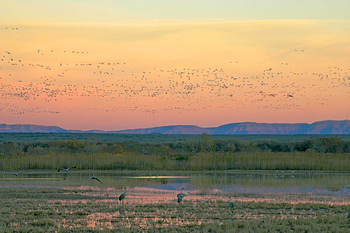
Bosque del Apache on Rio Grande south of Socorro, NM
Photo Credit: Lawrence Blank
State Parks is overseeing development of the trail from Belen to Sunland Park where they are already developing river trail in five state parks along the southern stretch of the Rio Grande. State Parks is undergoing a corridor study to identify and evaluate potential trail locations and constraints. Several stakeholder meetings, public workshops and surveys will be conducted to achieve community input in the planning process.
Environment New Mexico’s new report highlights the benefits a Rio Grande trail will provide for New Mexico in terms of the economy, conservation, health and recreation:
Trails are becoming increasingly popular nationwide and many are becoming destinations in and of themselves. The Rio Grande Trail has the ability to tap into this fervor, contributing to the state’s tourism sector and the $3.8 billion outdoor recreation industry.
The trail will provide avenues for historical and environmental educational opportunities—increasing awareness of New Mexican heritage and the problems facing the Rio Grande.
Improvement in public access to the Rio Grande will increase the connection New Mexicans have to the river and cultivate greater river stewardship.
Trails provide a number of different outlets for increasing one’s fitness. Creating or enhancing places for physical activity such as trails can lead to a 25.6 percent increase in the percentage of people exercising on three or more days per week.
It is estimated that New Mexico spends $324 million annually on direct adult medical costs that can be attributed to obesity. By curbing the obesity rate, New Mexico stands to save millions in healthcare costs.
The 2004 Statewide Comprehensive Outdoor Recreation Plan identified trails as the top recreation priority for the public in New Mexico.
“The Rio Grande Trail has the ability to preserve the Rio Grande and the Bosque by increasing public awareness and connection to the river while at the same time improving recreational opportunities and the health of New Mexico residents,” said Coleman.
The trail has already generated popular support in the New Mexico Legislature. In 2006 the Legislature appropriated $4 million for State Parks to begin planning and development of the trail, and in 2007 a joint House and Senate Memorial (HJM49/SJM44) was passed in support of completing the Rio Grande Trail.
“Despite all this support, there’s one catch. The major obstacle to trail development has been the lack of funding. Funding is scheduled to run dry this summer, following the completion of the planning study. More funding must be allocated if the Rio Grande Trail is to be realized,” said Coleman.
“During the 2008 legislative session, Governor Richardson and New Mexico’s legislators have a terrific opportunity to support trail funding and give New Mexico the benefits of a visionary river trail,” concluded Coleman.
Take Action
Environment New Mexico makes it easy to contact your legislators and the Governor, and write a letter to the editor about this issue:
All photos from Environment New Mexico's Rio Grande River collection on Flickr, where you can see full-sized versions of these and other photos, and you're encouraged to upload your own pics of scenic views along the Rio Grande.
January 16, 2008 at 09:23 AM in Environment, NM Legislature 2008 | Permalink | Comments (0)
Monday, January 14, 2008
Mayor Chavez Caught in the Act of "Greenwashing"
I received the video above in an email awhile back when Albuquerque Mayor Marty Chavez was still running for the U.S. Senate. This seems like a perfect time to post it.
Everyone's jumping on the bandwagon, pointing readers to John Fleck's excellent exposé of Albuquerque Mayor Marty Chavez's greenwashing that appeared in Sunday's Albuquerque Journal, so I thought I'd join the queue (so to speak). Fleck documents the inflated statistics and exaggerations that were once displayed on the City of Albuquerque website's Albuquerque Green "Q" page. Turns out that Marty's nonstop bragging about Albuquerque being the greenest metropolis in the universe (or variations thereof) was mostly hot air, like much of what he boasts about as his accomplishments. He's good at paying lip service. Unfortunately, his assertions too often often fall a little short of the truth.
Chantal over at Duke City Fix, who used to work on city cyberspace projects, provides a screen capture and useful link to the "Q" page as it once appeared before it was taken down when Fleck started poking around for the facts. Cocoposts also weighs in, and SWOPblogger features the Journal article itself. Meanwhile, Eye on Albuquerque discusses this and other examples of the Mayor's tendency to distort statistics to suit his political needs.
Aren't you glad Marty Chavez had the sense to withdraw from the New Mexico Senate race? Let's hope he has the same sense to refrain from running for Mayor again, despite his recent decision to challenge the term limits that apply to the office.
Sprawl Isn't Green
Chavez has worked hard to portray himself as a "green" mayor. Undoubtedly, Chavez has done some positive things for the environment, but there's a lingering problem that won't go away. During his tenure as mayor he's been known as the area's number one cheerleader for out of control, unregulated sprawl growth and the developers who make huge profits from it. You can't be for sprawl development and be "green," now can you?
When planned growth strategies were being debated in Albuquerque and considered by the City Council, Marty did everything he could to fight against it or to water it down. Marty became known as a fighter for developer interests, whether it was a road through the Petroglyph National Monument or a roadway situated so it destroyed a cottonwood hundreds of years old. Marty even posed in a photo op showing him jubilantly helping to cut the tree down.
Then there's his strong support for Tax Increment Financing (TIF) in the form of TIDDs designed to financially reward West Side developers for gobbling up greenfields and replacing them with sprawl, all at the taxpayers' expense. Check out our previous guest blog by Gabriel Nimms of 1000 Friends of New Mexico for more on that.
If Marty Chavez runs for Mayor again in 2009, you can rest assured he'll be facing big-time challenges on the basis of his greenwashing alone. Then there's all the other stuff ....
January 14, 2008 at 02:38 PM in 2009 Albuquerque Mayoral Race, Corporatism, Energy, Environment, Sprawl Development | Permalink | Comments (2)
(Updated) Richardson Issues 6-Month Moratorium on Drilling Permits in Galisteo Basin
Bob Gallagher of the NM Oil and Gas Association and activist David Bacon discuss drilling in Santa Fe County on KNME's NM In Focus Friday
The plot thickens. On January 11, 2008, Gov. Bill Richardson announced at a press conference that he will issue an executive order that delays consideration of Galisteo basin oil and gas drilling permits by the State for six months:
"I feel that there shouldn't be drilling in the Galisteo Basin," said Richardson. He described it as a "very fragile ecosystem" and said there were concerns that drilling could affect the area's groundwater and archaeological sites.
In November 2007, a three-month moratorium on the issuance of drilling leases was enacted by the Santa Fe County Commission in response to a growing uprising by citizens and environment groups against drilling proposed by Tecton Energy of Houston. The County Commission is currently drafting a revised oil and gas drilling ordinance prompted by renewed interest in drilling in the County. The first public meeting on the proposed new law is currently scheduled for January 22, 2008, but it's unclear whether the County will now postpone the meeting due to the Governor's moratorium.
Also late last week, Rep. Tom Udall (NM-03) and Sen. Jeff Bingaman called upon Santa Fe County to hold off on issuing drilling leases until an archaeological management plan mandated by legislation they cosponsored, and which was enacted into law in March 2004, is funded and completed. They also urged the Bush adminstration's Office of Management and Budget Director Jim Nussle, to provide the funding for the Secretary of Interior to undertake the comprehensive study of the archeological assets of the basin and to determine what actions are needed to protect them. (See my previous post.)
In response to these actions, Santa Fe County issued the following statement late Friday:
NO OIL & GAS DRILLING PERMITS CONSIDERED FOR 6 MONTHS
Santa Fe, NM – January 11, 2008 – Effective today and continuing for the next 6 months, no oil and gas drilling applications will be considered by the State. The 6 month moratorium, announced today by Gov. Bill Richardson, is put in place to allow time to ensure the protection of water, archaeological resources, and fragile ecosystems in the Galisteo Basin.Santa Fe County will be working closely with the State Oil Conservation Division during this time as it continues to work on an oil and gas drilling ordinance. County officials are currently considering the ramifications of the announcement. More information regarding next steps, possible hearing cancellations, and a new ordinance schedule will be available next week.
For more background on this issue, visit the websites of Drilling Santa Fe and Santa Fe Not Oil. Also check out the video at the top of this post of Friday's New Mexico In Focus show (episode 119) on KNME that featured a spirited discussion about oil and gas drilling in Santa Fe County with activist David Bacon and Bob Gallagher, President of the New Mexico Oil and Gas Association, moderated by host David Alire Garcia. Don't miss it.
January 14, 2008 at 09:58 AM in Energy, Environment, Local Politics | Permalink | Comments (1)
Sunday, January 13, 2008
Environmental Alliance of NM Announces 2008 Legislative Agenda
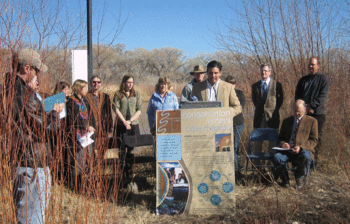
Javier Benavidez of Conservation Voters New Mexico
speaks at press conference at Rio Grande bosque
From Conservation Voters New Mexico:
Representatives of over a dozen environmental organizations convened a news conference on Friday afternoon, January 11, 2008, in Albuquerque to announce a 2008 legislative package aimed at addressing the State of New Mexico’s environment, energy, water, and outdoor education policy. The Environmental Alliance of New Mexico, an informal coalition of environmental organizations facilitated by Conservation Voters New Mexico, announced four priority legislative measures. Though this year’s legislative session will be a short, 30-day session focusing on state budget matters, each of the alliance’s priority bills will be on the legislative agenda because they are germane to state budgeting or because they are anticipated to be on the “Governor’s call.” The bills include:
• the “Leave No Child Inside Act,” a bill seeking to generate revenue for an outdoor educational programming fund through a 1% excise tax (a “sin” tax) on the purchase of new televisions and video games
• the “Ratepayer Protection Act,” a bill requiring regulated electric utilities to meet 10% of their energy demand with energy efficiency by 2020 instead of building new power plants (which are more expensive than efficiency). The bill will also encourage the New Mexico Public Regulation Commission to allow energy efficiency programs to be as profitable to New Mexico utilities as power plants are.
• a “Smart Investments in Public Buildings” policy to ensure a 50% energy saving throughout the life of new and retrofitted public buildings through a 1-2% initial investment in the “sustainable” or “green” design of each public building
• a one-time funding request of $10 million for Statewide Ecosystem Restoration that will facilitate efforts to restore New Mexico’s fragile and iconic river ecosystems, including funding for water flows, technical studies and community outreach.
"This alliance represents over 30,000 New Mexican voters who care about protecting our air, land, water, wildlife and communities,” said Sandy Buffett, Executive Director of Conservation Voters New Mexico and the Conservation Voters of New Mexico Education Fund.
The four priority bills of the Environmental Alliance of New Mexico (click for Fact Sheet) are the result of an annual “common agenda” process in which environmental organizations come together to develop a cohesive environmental policy agenda for consideration by the annual state legislative session. In addition to the measures mentioned above, Conservation Voters New Mexico will be monitoring any potential “environmental rollbacks” of policy gains made in previous years and will work to defend against such regressive measures.
Organizations involved in the Environmental Alliance of New Mexico include: 1000 Friends of New Mexico, Animal Protection Voters, Amigos Bravos, Audubon New Mexico, Conservation Voters New Mexico, Defenders of Wildlife, Dooda Desert Rock, Environment New Mexico, New Mexico Coalition for Clean Affordable Energy, New Mexico Environmental Law Center, New Mexico Wilderness Alliance, New Mexico Wildlife Federation, Sierra Club, The Natural Resources Defense Council, The Nature Conservancy, and the World Wildlife Fund.
For more information, please contact Sandy Buffett, Executive Director of Conservation Voters New Mexico, at 270-5743.
Click for contact information for your legislators.
January 13, 2008 at 12:13 PM in Energy, Environment, NM Legislature 2008 | Permalink | Comments (3)
2008 NM Wild Guide Now Available
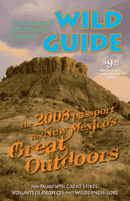 From the NM Wilderness Alliance:
From the NM Wilderness Alliance:
The New Mexico Wilderness Alliance has just released its “2008 Wild Guide, The Passport to New Mexico’s Great Outdoors.” Copies are going fast! Get yours today. Order A Copy Online Right Now!
Sponsored by REI, this year’s Wild Guide is jam-packed with great hikes, volunteer service projects and Wilderness lore. Included are 48 hikes, some of which are self-guided, but most are lead by the New Mexico Wilderness Alliance. There are nine backpacking trips, four car-camps, and 27 volunteer service projects all across the state. Some of our projects venture into areas that are not normally open to the public.
Through the numerous hikes, backpacks, and Wilderness service projects we aim to build awareness and support for the protection of these special landscapes – all while having FUN! The 2008 Wild Guide captures a wide variety of experiences while showcasing some of our states greatest wilderness resources and potentials. Additionally, there are cooking recipies, safety tips, stories written by outdoor enthusiasts, and much more.
January 13, 2008 at 10:26 AM in Books, Environment | Permalink | Comments (0)
Friday, January 11, 2008
Bingaman & Udall Urge Funding of Galisteo Basin Study, Ask County to Delay Leases
The Santa Fe County Commission will hold its first public hearing on their proposed new oil and gas drilling ordinance on January 22, at 3:00 PM in Santa Fe Community College’s Jemez room. A second public hearing is set for February 12 at 6:00 PM in the County Commission chambers.
In the meantime, two of New Mexico's members of Congress are working on another aspect of protecting New Mexico's unique treasures from potential damage from Tecton's proposed drilling in the Galisteo Basin, and have issued this statement:
WASHINGTON - U.S. Senator Jeff Bingaman and Representative Tom Udall are pressing the Bush administration for funding to produce an archaeological management plan for the Galisteo Basin, which is home to the largest ruins of Pueblo Indian settlements in the United States, spectacular examples of Native American rock art, and ruins of Spanish colonial settlements.
Simultaneously, the lawmakers have asked the Santa Fe County Commission to delay the issuance of drilling leases in the area until the management plan is completed.
In a letter to Office of Management and Budget Director Jim Nussle, Bingaman and Udall cite the Galisteo Basin Archaeological Sites Protection Act, legislation they sponsored, which became Public Law No: 108-208 on March 19, 2004. Their legislation requires the Secretary of Interior to undertake a comprehensive study of the archeological assets of the basin and to determine what actions are
needed to protect them.
In their letter to Nussle, the lawmakers said, "We included this language because we know we have only just begun to take stock of all the prehistoric and historic archeological resources in this area yet they are constantly under threat of ruin by natural causes, urban development, vandalism, and uncontrolled excavations."
Bingaman and Udall expressed their deep concern that nearly four years after their legislation was enacted no funds have been proposed or released to recommend new areas for protection or to develop a management plan. They pressed Nussle to adequately fund the study, as directed by law, in fiscal year 2009.
In a separate letter to Santa Fe County Commissioners, Bingaman and Udall also urge the Santa Fe County Commission to "delay issuing leases for any activities, such as exploration or drilling, that have the clear potential to permanently disturb or destroy irreplaceable historic artifacts in the Galisteo Basin."
Text of the letters to both Director Nussle and the Santa Fe County Commission are included below.
Jim Nussle
Director, Office of Management and Budget
725 17th Street, NW
Washington, DC 20503
Dear Director Nussle,
We are writing with regard to the Galisteo Basin Archaeological Sites Protection Act, which became Public Law No: 108-208 on March 19, 2004. This law was written to help protect the many well preserved prehistoric and historic archaeological resources of Native American and Spanish colonial cultures found in the Galisteo Basin of New Mexico.
This law mandates that the Secretary of the Interior shall continue to search for additional Native American and Spanish colonial sites in the Galisteo Basin area and, within three years of funding being made available, make recommendations for additions to, deletions from, and modifications of the boundaries of the list of archaeological protection sites in the Act. We included this language because we know we have only just begun to take stock of all the prehistoric and historic archeological resources in this area yet they are constantly under threat of ruin by natural causes, urban development, vandalism, and uncontrolled excavations. The Secretary is further directed by the Act to, within three years of funding being made available, develop a management plan to provide for the identification, research, protection, and public interpretation of sites in the Basin.
We are deeply concerned that, to date, no funds have been proposed for either of these purposes. The threats remain, and these invaluable resources continue to degrade. We ask that as you prepare the budget for Fiscal Year 2009 you include adequate funding to commence the investigation, cataloguing and preservation of the uniquely North American archeological treasures in the Galisteo Basin of New Mexico.
Thank you very much for your prompt consideration of our request.
Santa Fe County Commission
102 Grant Avenue
Santa Fe, New Mexico 87501
Dear Commissioners:
In 2004, we sponsored and passed into law the Galisteo Basin Archaeological Sites Protection Act because many well preserved prehistoric and historic archaeological resources of Native American and Spanish colonial cultures were found in the Galisteo Basin and the surrounding area, but were yet to be fully identified and protected. These resources, in large part unique to New Mexico, include the largest ruins of Pueblo Indian settlements in the United States, spectacular examples of Native American rock art, and ruins of Spanish colonial settlements. Over time, it was becoming evident that these invaluable resources were being threatened by decay and erosion, urban development, vandalism, and uncontrolled excavations.
The law states that the Secretary of the Interior must continue to search for additional Native American and Spanish colonial sites in the Galisteo Basin area and, within three years of funds being made available, make recommendations for additions to, deletions from, and modifications of the boundaries of the list of archaeological protection sites. Additionally, the Secretary is directed to prepare a general management plan for the identification, research, protection, and public interpretation of the archaeological protection sites located on federal land and for sites on state or private lands for which the Secretary has entered into cooperative agreements.
The identification and development of plans for the protection of the wealth of historic artifacts that exist in this area is still in its early stages. Accordingly, we ask you to delay issuing leases for any activities, such as exploration or drilling, that have the clear potential to permanently disturb or destroy irreplaceable historic artifacts in the Galisteo Basin. We will continue to work to secure the federal funding necessary to complete these surveys.
We thank you for your consideration.
**************
For more info on these issues, visit these websites:
Also see our previous post, which contains links to older posts and other sources of info.
January 11, 2008 at 02:08 PM in Energy, Environment, Local Politics, Native Americans | Permalink | Comments (0)
(Updated) Tonight's NM In Focus: Galisteo Basin Drilling, Richardson Prez Campaign
UPDATE 1/14/08: You can see video of Friday's show by visiting my subsequent post on this controversial issue.
***************
 You can tune into this week's New Mexico In Focus on KNME public television tonight at 7:00 PM, with a repeat airing on Sunday at 6:30 AM. The In Focus segment of the show will take a hard look at the future of oil and gas drilling in New Mexico and the latest battleground in the fight over this precious resource: the Galisteo Basin. David Alire Garcia sits down with David Bacon, energy consultant, advocate and former Green Party candidate for the PRC, and Bob Gallagher, President of the New Mexico Oil and Gass Association, for a look at an industry that brings in millions of dollars per year to the state, but is under pressure by many who want tighter regulations to minimize or eliminate environmental threats posed by increased drilling.
You can tune into this week's New Mexico In Focus on KNME public television tonight at 7:00 PM, with a repeat airing on Sunday at 6:30 AM. The In Focus segment of the show will take a hard look at the future of oil and gas drilling in New Mexico and the latest battleground in the fight over this precious resource: the Galisteo Basin. David Alire Garcia sits down with David Bacon, energy consultant, advocate and former Green Party candidate for the PRC, and Bob Gallagher, President of the New Mexico Oil and Gass Association, for a look at an industry that brings in millions of dollars per year to the state, but is under pressure by many who want tighter regulations to minimize or eliminate environmental threats posed by increased drilling.
Also, host Gene Grant and The Line panel will be discussing Gov. Bill Richardson's withdrawal as a candidate for the Democratic presidential nomination and the highlights and lowlights of his campaign, as well as the upcoming legislative session. Guest panelists include New Mexico bloggers Mario Burgos and Heath Haussamen, and John Wertheim, former New Mexico Democratic Party chairman.
January 11, 2008 at 12:06 PM in 2008 Presidential Primary, Energy, Environment, Local Politics, Media | Permalink | Comments (0)
NM Mining Claims Jump: Officials Urge Reform Legislation
Proposed oil and gas drilling in Santa Fe County has prompted a citizen uprising in New Mexico, but increases in other kinds of claims to exercise mineral rights are also being challenged. Yesterday a press conference was held in Albuquerque about the need for reforming the 1872 federal mining law with participation from the Haaku Tribal Water Office/Acoma Pueblo, Dine Against Uranium Mining, Conservation Voters New Mexico, New Mexico Wilderness Alliance, and Environment New Mexico. Here's their statement about this pressing issue and what needs to be done to safeguard the integrity of Western lands and communities and require that mining companies pay a fair share of royalties on their profits to taxpayers:
Albuquerque, N.M. – In the face of dramatic increases in new mining claims in New Mexico, state and county officials called on Senators Jeff Bingaman and Pete Domenici, leaders of the Senate Energy and Natural Resources Committee, to reform the 135-year-old law that governs the mining of gold, uranium and other hardrock minerals on federal lands in New Mexico and other western states.
A comprehensive bipartisan package that would modernize the Civil War era statute was passed by the House of Representatives in November. The Senate will host its first mining reform hearing this month.
“This year, New Mexico will take center stage in the effort to reform the 1872 Mining Law,” said Gregory Greene of the Pew Campaign for Responsible Mining. “Senators Bingaman and Domenici can play a lead role in protecting the health of New Mexico’s communities, lands, water and wildlife by producing a modern framework for mining that protects taxpayers and the environment. We all have a stake in their success.”
The 1872 mining law, signed by President Ulysses S. Grant, offers special status to those filing claims on public lands -– without safeguarding watersheds, wildlife or communities from the messy business of mining. It also allows mining companies to take minerals from public lands without compensating taxpayers, while oil, gas and coal industries have been paying royalties for decades.
New Mexico has had a significant share of mining-related disasters. In 1979, 94 million gallons of radioactive, acidic mine tailings spilled into the Rio Puerco. The release from the site, promoted as a modern and safe treatment facility, is the largest release of liquid radioactive waste in U.S. history. Thirty years later, the impacts of that spill still linger.
The need for reform has also been made more urgent by the dramatic increase in new mining claims in western states, including New Mexico. According to Bureau of Land Management data analyzed by the Environmental Working Group, the total number of hardrock mining claims in New Mexico is 50 percent higher in mid-2007 than in 2003. Claims totaled 11,348 in July of 2007.
“The state of New Mexico has a stake in federal mining law reform,” said Bill Brancard, Director of New Mexico Mining and Minerals Division. “While the state has created significant safeguards for water, we needs federal mining law reform that includes resource protection and a reasonable royalty.
“We’ve shown that you can have stringent protections for mining yet still have a viable, productive mining industry,” said Brancard.
“Counties have a stake in mining reform,” said Deanna Archuleta, Bernalillo County Commissioner. “We're dealing with an antiquated law where the taxpayers are left with the clean-up, and it's a financial burden on everybody for a few to make a profit. We ask Senators Bingaman and Domenici to take this opportunity to take the lead at reform at the federal level.”
“Sportsman have a stake in mining reform,” said Kent Salazar, president of the New Mexico Wildlife Federation. “Our public lands are the source of our best fishing, elk hunting and wildlife habitat, and we pay user fees to hunt and fish. It's time the industry also paid its own way, and took on the cost of mine cleanup.”
On January 24, the Senate Energy and Natural Resources Committee will hear testimony about the need for mining law reform and is expected to produce a bill by late February. The hearing follows passage late last year of H.R. 2262, which provided fundamental reform measures.
To contact New Mexico's U.S. Senators about this issue click:
January 11, 2008 at 11:36 AM in Energy, Environment | Permalink | Comments (0)



















